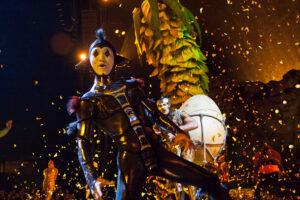Share This:
June 30, 2016 | Theatre,
The Evolving Circus: From Elephants to Acrobatics
When someone tells you they’re taking you to the circus what do you imagine?
Originally developed as a source of entertainment focused on heroic acrobatic skills and equestrian acts in England, the circus has tremendously evolved since its days of being limited to the 13 diameter circle. According to theatre historian George Speaight, the circus was once simply known as “the story of that entertainment of human bodily skills and trained animals.”
Although shows with zoological exhibitions, acrobatic stunts, and animal tricks had developed by the early 18th century, placing these elements within a circle is when the concept of the “circus” was definitively coined. Early circus pioneers were constantly trying to find ways to incorporate new ideas, eventually moving beyond mere clowns and pony tricks. By the 19th century, audiences were witnessing additions like the tight rope act, the flying trapeze, and the breakaway ladder —all of which were audience raves.
Before selling out grand stages and arenas, circuses were originally housed in amphitheaters, and wooden warehouses. The idea of using tents for outdoor performances originated in America in the 1840s. The tent added a new sense of complexity to performances. Parades and difficult acts of acrobatic skills became mainstays of the new modern circus.
The development of the railway aided in the reinvention of the 19th century circus in America. Troupes were able to go on national tours, hauling their sets, props, animals and performers across the country. Circus troupes like the Barnum and Bailey Brothers became household names, known for their large cast, extravagant animals, production numbers, and side shows. Their set was known to span across 60-70 train carriages.

Phineas T. Barnum and James A. Bailey are known as the forerunners that changed the structure of the American circus. Together the two would redefine and set the bar for circuses for more than a century. Their large extravagant sets served as models for logistic efficiency, proving them to be the competition to beat in their early days. Audience members were completely fascinated by the circus troupe’s most famous attraction at the time, the legendary elephant, Jumbo.
Barnum and Bailey had long set the standard for what makes a great circus. Troupes they found themselves in competition with often offered smaller scaled, less appealing productions. From their start in the 19th century and well into the 20th century, Barnum and Bailey circus productions remained a house hold name until the 1980’s when Cirque du Soleil arrived on the scene. Cirque paid no heed to conventional and traditional circus standards, they surpassed their competition by offering a fun, thrilling production with some ideas borrowed from Broadway. Three decades later, they are known as the “God-Father” of the contemporary circus, making way for troupes like Les 7 Doigts de la Main aka The 7 Fingers.

The 7 Fingers was founded by seven colleagues who came together to create a new form of circus, drawing in decades of circus and theatrical experience. While some of its founders are associated with Cirque du Soleil, the differences between the troupes are inevitable and noted in the overall production aesthetics of each company. Cirque du Soleil gives it’s audiences an overall thematic experience with an epic story and extravagant stunts. In contrast, The 7 Fingers, often described as the “Rebel Circus,” creates a personal intimate performance that’s focused around camaraderie and treats their acrobatic stunts as forms of acting. But with all the troupes’ distinct differences, it’s hard not to note their shared authenticities and overall goal to provide audience members with an entertaining, gratifying experience.
Circus troupes today have created an uncontested market that took circus troupes from the past centuries to achieve. There was a time when three rings, animal shows, star performers, and aisle concession sales could once fill an arena. But in a world where video games and other variations of live entertainment exist, modern circus had to change its approach on how audience members were reached. Troupes like Cirque du Soleil and The 7 Fingers, have done away with traditional circus standards—the tent, clowns, the elephants—while classic acrobatic acts have become the focus. Modern cirus incorporates new media, dance, and often revolves around a theatrical skit or narrative. In short, they kept the clown and made it more sophisticated, glamorized the tent, and enhanced the theatrical flair of the acrobatic performers.

To kick off our 2016-2017 season, ArtsEmerson is excited to welcome back The 7 Fingers as they present the US Premiere of Cuisine and Confessions. In past seasons the troupe has presented jaw-dropping performances of their shows Traces, Sequence 8, and Psy. The 7 Fingers is known for giving its audiences intimate and exhilarating performances, mixing elements of the past while reinventing the circus for the Facebook generation. They are redefining a tradition set over 250 years ago by adding a level of enlightened intelligence and artistic richness. Prepare to experience a performance pushing the boundaries of the circus and leaving audiences in awe around the world.
Cuisine & Confessions runs in Boston JUL 12- AUG 7 at the Emerson/Cutler Majestic Theatre in downtown Boston.
For more information regarding tickets and performance dates visit www.artsemerson.org




Leave a Reply